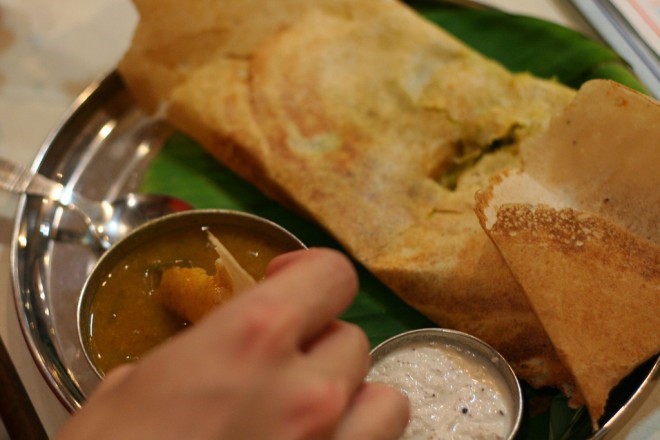When most people think about “eating Indian food” in America – what they’re actually thinking about is a nationalized uniform version of Indian food. Most don’t realize that the regional diversity of Indian cuisine is as distinguished as its culture.
Each region of India has its unique varieties. A book could be written about the culinary intricacies of each region.
India has 29 states and seven union territories, but for the purpose of this blog post, we are dividing India into four regions: South India, North India, East India, and West India.
South Indian Cuisine

Source: RoughGuides
South India has five states: Kerala, Tamilnadu, Andhra Pradesh, Karnataka, and Telangana. Culture and geographic region play an important rule in South Indian food. The climate is hot and humid with most of the states being near the coast. South Indians are primarily vegetarian, yet pescetarianism is very common as the inhabitants are fond of seafood.
All things considered, South Indian food is the spiciest among all other regions. Most of the food is hinged around rice. Rice is pooled with sambar which is a soup-like lentil dish tempered with chilies and spices. Sambar is another soup-like lentil dish and is usually centered with rasam.
It’s common for hosts in South India to offer their guests papadum (crispy lentil pancakes), coconut based chutneys, and filtered coffee.
South Indian Staples
A meal is not complete without some form of rice complement. Lentils are a close second to rice. South-Indian favorites like idlis, which are basically steamed cakes prepared from rice batter and dosas, which are crepe-like pancakes, both contain Lentils.
Essential ingredients and spices: fenugreek seeds, chilies, tamarind, pepper and peppercorns, asafetida, mustard, and curry leaves.
North Indian Cuisine

Source: FranchiseIndia
The climate of North India flirts with both extremes of the spectrum. They have frigid winters and scorching summers. The states in North India include Madhya Pradesh, Chattisgarh, Jharkhand, Bihar, Haryana, Uttar Pradesh, Uttaranchal, Punjab, Himachal Pradesh, and Jammu & Kashmir.
Its connection with the sub-continent (commonly referred to as South Asia) influences both its food and culture. Two types of cuisines dominate North India – Kashmiri and Mughlai.
The curries of North India are moderately creamy, spicy, and thick. The use of nuts and other dry fruits are common. Dairy products like yogurt, milk, ghee, cottage cheese, and cream play a constituent role in the cooking style of both sweet and savory cuisines. The region also produces a dazzling amount of vegetarian foods, thanks to a large variety of vegetables and fruits which are available throughout the year.
North Indian Staples
North India is home to many different types of rotis (bread), but the most famous of these include tandoori naan, a bread prepared in a clay oven, and stuffed paratha, a flatbread commonly stuffed with vegetarian fillings. Mouthwatering Kulchas are also popular here; they are bread prepared from the fermented dough. Like South Indian culture, Rice is also renowned here but takes a more masala heavy-form in dishes like pulao and biryani.
Essential ingredients and spices: aniseed/fennel, garam masala, cloves, cinnamon, cardamom, chili powder, turmeric, dry red chilies, coriander, and cumin.
East Indian Cuisine

Source: InternetBusinessIdeas
East India is known for its mountains and beaches. The states of East India include Tripura and Orissa, Mizoram, Nagaland, Manipur, Meghalaya, Arunachal Pradesh, Assam, Sikkim, and West Bengal.
The favorable climate allows the region to grow a lot of fruit, vegetables, and rice. Vegetarian and non-vegetarians both feel at home in East India. Mongolian and Chinese cuisines have a strong influence in East India due to its proximity and history with the countries.
Three different schools of food rule East India – Orissa, Assam, and Bengali. Simplicity is common among all three. Preparations of the food are not elaborate, and people have a minimalist approach to ingredients. Frying and steaming are the prominent methods of cooking. Coastal areas take serious pride in their fish.
East Indian Staples
Sweets reign supreme in East India. Favorites include Sandesh, prepared from sugar and paneer, Rasgulla, made with dumplings in syrup, and Kheer, creamy rice pudding.
Essential ingredients and spices: mustard oil, yogurt, gram flour, maize, chilies (both red and green), and panch phoran (consist of five species: seeds of fenugreek, fennel, mustard, onion, and cumin).
West Indian Cuisine

Source: DifferenceBetween
States that encompass West India include Goa, Maharashtra, Gujarat, and Rajasthan. The states of Gujarat and Rajasthan have relatively drier climates that produce fewer vegetables.
Culturally, West India is vegetarian. Coconut and peanuts are predominant ingredients, and they are widely available. Goa has a lush green coastline that offers a variety of fresh seafood. Dishes like Xacuti and Vindaloo pay homage to the fact that until the 1960s, West India was a Portuguese colony.
We find an eclectic variety of dishes in West India. Rajasthani cuisine consists mostly of vegetables and usually has a spicy kick. Meats also have a home in Rajasthan — Laal Maas, which is a red meat curry, is popular across the state.
Gujarat, on the other hand, is known for its sweet tooth. Many dishes add at least a pinch of sugar in Gujarat. Thaalis are a hallmark of Gujarati culture. These infamous giant plates contain various dishes including chapati, rice, sweets, and more.
The coastal areas like Maharashtra are popular for Malvani food, a coconut based sour curry that is usually eaten with seafood.
West Indian Staples
In Rajasthan and Gujarat: lentils, corn, dry red chilies, gram flour, yogurt, buttermilk, nuts, and sugar. In Maharashtra: rice, fish, peanuts, coconut, Goa fish and rice.
Essential ingredients and spices: fish, vinegar, nuts, coconut, sesame seeds, sugar, and dry red chilies.
We hope you enjoyed our dive into the different regions of India. Get social with us! Let us know which region is your favorite.
East Indian Food Indian Food North Indian Food South Indian Food West Indian Food